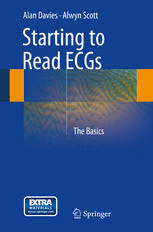
Starting to Read ECGs: The Basics PDF
Preview Starting to Read ECGs: The Basics
Alan Davies · Alwyn Scott Starting to Read ECGs The Basics 123 Starting to Read ECGs Alan Davies (cid:129) Alwyn Scott Starting to Read ECGs The Basics Alan Davies Alwyn Scott Plymouth Cardiology High Dependency Unit UK Papworth Hospital NHS Foundation Trust Cambridge UK ISBN 978-1-4471-4961-3 ISBN 978-1-4471-4962-0 (eBook) DOI 10.1007/978-1-4471-4962-0 Springer London Heidelberg New York Dordrecht Library of Congress Control Number: 2013954810 © Springer-Verlag London 2014 This work is subject to copyright. All rights are reserved by the Publisher, whether the whole or part of the material is concerned, specifi cally the rights of translation, reprinting, reuse of illustrations, recitation, broadcasting, reproduction on microfi lms or in any other physical way, and transmission or information storage and retrieval, electronic adaptation, computer software, or by similar or dissimilar methodology now known or hereafter developed. Exempted from this legal reservation are brief excerpts in connection with reviews or scholarly analysis or material supplied specifi cally for the purpose of being entered and executed on a computer system, for exclusive use by the purchaser of the work. Duplication of this publication or parts thereof is permitted only under the provisions of the Copyright Law of the Publisher's location, in its current version, and permission for use must always be obtained from Springer. Permissions for use may be obtained through RightsLink at the Copyright Clearance Center. Violations are liable to prosecution under the respective Copyright Law. The use of general descriptive names, registered names, trademarks, service marks, etc. in this publication does not imply, even in the absence of a specifi c statement, that such names are exempt from the relevant protective laws and regulations and therefore free for general use. While the advice and information in this book are believed to be true and accurate at the date of publication, neither the authors nor the editors nor the publisher can accept any legal responsibility for any errors or omissions that may be made. The publisher makes no warranty, express or implied, with respect to the material contained herein. Printed on acid-free paper Springer is part of Springer Science+Business Media (www.springer.com) This book is dedicated to the memory of: Valerie Jane Davies 1955–2000 Foreword There are several textbooks comprehensively covering the fi eld of ECG interpreta- tion and this book does not attempt to replicate these texts. The purpose of this book is to provide a concise, practical and systematic guide to interpretation of ECGs for the beginner. It not only covers how to perform an ECG but also basic interpretation of a normal ECG before progressing onto the effects of anatomical abnormalities of the heart on the ECG. More complex rhythm abnormalities are described and illus- trated to ease understanding. The ECG should always be interpreted whilst consid- ering the clinical presentation of the individual subject from whom it was recorded. The ECG is part of diagnosis and management. Clinical scenarios affecting the ECG are also described in the last two chapters. Each chapter concludes with a quiz for refl ective learning and a summary of key points from the chapter. The authors should be congratulated for producing a well presented and easy to understand text which will be useful to medical students, nurses and other allied professionals not only as a starter text but also as an immediate bedside reference manual. Cambridge, UK Sarah Clarke vii Pref ace The ECG is one of the most widely available diagnostic tests used in clinical prac- tice today. Since the fi rst use of the ECG there has been a wealth of books available on the subject, aimed at all sorts of different experience levels and healthcare prac- titioners. With such a wealth of material already available you may ask yourself what is special or different about this book. The authors have tried very hard to write a book that is aimed at the absolute beginner. Many make this claim, but we have really tried to strip everything back to essential basics. We pick simple methods that can be used easily in clinical practice. We do not assume any prior knowledge. Above all we wanted the book to be easy to read and attractive, using many photos, images and diagrams to illustrate points and aid in memory retention. We constantly revisit and remind the reader of infor- mation already covered to reinforce knowledge. We gradually build on the informa- tion given throughout the book, so as not to overload the reader with too much in one go. This book aims to give the beginner just what they need to know, including infor- mation about how to record good quality ECGs. We hope to avoid information overload, although extra information and points of interest are included in informa- tion boxes. We hope you will fi nd this book easy to read, informative, and a useful aid in building your ECG knowledge and confi dence in interpretation, whatever your clin- ical role may be. Plymouth, UK Alan Davies ix
